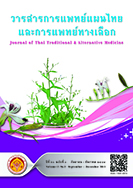A Quantitative Study on Artifacts Occuring in Prasa-Plai Preparation in the Pill and Capsule Forms
Main Article Content
Abstract
This study is to compare the artifacts obtained from Prasa-Plai (Thai Traditional Medicine for dysmenorrheal) in two preparations: pill form and capsule form. The reference standard compounds were synthesized: Compound D; (E)-4-(3,4-dimethoxyphenyl)but-3-en-1-yl linoleate (Artifact 1); (E)-4-(3,4-dimethoxyphenyl)but-3-en-1-yl oleate (Artifact 2); and (E)-4-(3,4-dimethoxyphenyl)but-3-en-1-yl palmitate (Artifact 3). Quantitative analysis of these compounds are developed by using High Performance Liquid Chromatography (HPLC), which is high in accuracy and efficiency. Three dosage forms of Prasa-Plai were prepared: capsule form, pill with honey and pill with simmered honey forms. In 49 days, the drugs in three forms were analyzed. The artifacts of Prasa-Plai in pill with honey and pill with simmered honey forms clearly occurred less than in the capsule form 1.57–2.07 times and 1.86-2.60 times respectively. The reason is due to the humidity
in the pill slows down esterification reaction. There is no difference in the artifacts between pill with honey and pill with simmered honey forms statistically significance (p<0.01). Thus, to avoid the artifacts in Prasa-Plai with unknown activities yet, ones should use in pill form either with honey or simmered honey.
Article Details
References
2. Nualkaew S, Gritsanapan W, Petereit F, Nahrstedt A. New fatty acid esters originate during storage by the interaction of components in Prasaplai, a Thai traditional medicine. Planta Medica. 2004;70:1243–6.
3. Tangyuenyongwatana P, Gritsanapan. Mechanism evaluation of artifacts formation in Prasaplai preparation, a Thai traditional medicine. Planta Medica. 2008;74:1403–5.
4. Tangyuenyongwatana P, Gritsanapan W. Quantitative analysis and toxicities determination of artifacts originated in a Thai traditional medicine Prasaplai. Pharmaceutical Biolology. 2010;48(5):584–8.
5. Tangyuenyongwatana P, Gritsanapan W, Kowapradit J, Opanasopit P. Cellular transport of anti-inflammatory pro-drugs originated from a herbal formulation of Zingiber cassumunar and Nigellar sativa. Chinese Medicine. 2009;4:19.
6. Neises B, Steglich W. Simple method for the esterification of carboxylic acids. Angewandte Chemie International Edition. 1978;17:522–4.
7. Abramovič H, Jamnik M, Burkan L, Kač M. Water activity and water content in Slovenian honeys. Food Control. 2008;19:1086–90.
8. Flamini C, Morlot M, Lheretier J, Borneck R, Marioleas P, Tsigouri A, et al. Honey quality, method of analysis and international regulatory standards: Review of the work of the international honey commission. Swiss Bee Research Centre. 2000;5:1–15.


